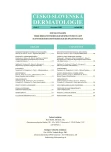The Significance of Diagnostic Hypoallergenic Diet in Patients with Atopic Eczema
Authors:
J. Čelakovská 1; K. Ettlerová 2; K. Ettler 1; J. Vaněčková 1; J. Bukač 3
Authors‘ workplace:
Klinika nemocí kožních a pohlavních FN a LF UK Hradec Králové, přednosta doc. MUDr. Karel Ettler, CSc.
1; Ambulance klinické imunologie a alergologie, Hradec Králové, vedoucí MUDr. Květuše Ettlerová
2; Ústav lékařské biofyziky LF UK Hradec Králové, přednosta doc. Ing. Josef Hanuš, CSc.
3
Published in:
Čes-slov Derm, 86, 2011, No. 3, p. 138-143
Category:
Clinical and laboratory Research
Overview
Aim:
To evaluate the effect of the diagnostic hypoallergenic diet on the severity of atopic eczema in patients over 14 years of age. The diet is an important step in the diagnostic workup of the food allergy in this group of patients.
Methods:
The diagnostic hypoallergenic diet for the period of 3 weeks was recommended to patients suffering from atopic eczema. The severity of atopic eczema was evaluated at the beginning and at the end of the diet (SCORAD I, SCORAD II), the difference of SCORAD was evaluated statistically.
Results:
149 patients completed the diet: 108 females and 41 males with the average age of 26.03 (SD 9.6 years), min. 14, max. 63 years; with the median SCORAD I 32.9 points, SD 14.11 at the beginning of the study and with the median SCORAD II 25.2 points, SD 9.99 at the end of the diet. The difference between SCORAD I and SCORAD II was evaluated with Wilcoxon signed-rank test. The average decrease of SCORAD was 7.7 points and was calculated as substantial (p-value = 0.0001).
Conclusion:
On the basis of our results we recommend to introduce the diagnostic hypoallergenic diet as a temporary medical arrangement in patients suffering from moderate or severe form of atopic eczema. The diet shall serve as the important diagnostic test in the diagnostic workup of food allergy especially in those with the severe form of eczema.
Key words:
atopic eczema – diagnostic hypoallergenic diet – SCORAD
Sources
1. BATH-HEXTALL, F., DELAMERE, F. M., WILLIAMS, H. C. Dietary exclusions for establihed atopic eczema. Cochrane Database syst Rev 2008, 23, 1, CD005203.
2. BREUER, K., WULF, A., CONSTIEN, A., TETAU, D., KAPP, A., WERFEL, T. Birch pollen – related food as a provocation factor of allergic symptoms in children with atopic eczema/dermatitis syndrome. Allergy, 2004; 59, p. 988–994
3. ČELAKOVSKÁ, J., ETTLEROVÁ, K., ETTLER, K., VANĚČKOVÁ, J., BUKAČ, J. Význam atopických epikutánních testů a dalších vyšetřovacích metod v diagnostice potravinové alergie na kravské mléko a pšeničnou mouku u pacientů s atopickým ekzémem ve věku nad 14 let. Čs. Derm., 2009, 84, 5, p. 254–263.
4. ČELAKOVSKÁ, J., ETTLEROVÁ, K. Could food allergy testing be beneficial in adult patients with atopic dermatitis? Three case-reports. Revue francaise d’allergologie, 2009, 49, 8, p. 593–599.
5. ČELAKOVSKÁ, J., ETTLEROVÁ, K., ETTLER, K., VANĚČKOVÁ, J., BUKAČ, J. Význam atopických epikutánních testů a dalších vyšetřovacích metod v diagnostice potravinové alergie na arašídy u pacientů s atopickým ekzémem starších 14 let. Význam pylové alergie u této skupiny pacientů. Čs. Derm., 2009, 84, 6, p. 332–340.
6. ČELAKOVSKÁ, J., ETTLEROVÁ, K., ETTLER, K., VANĚČKOVÁ, J., BUKAČ, J. Význam potravinové alergie na sóju u pacientů s atopickým ekzémem starších 14 let. Čs. Derm., 2010, 85, 1, p. 14–20.
7. DAVID, T. J., PATEL, L., EWING, C. I., STANTON, R. H. J. Dietary factors in established atopic dermatitis. In Williams, H., editor. The epidemiology, causes and prevention of atopic dermatitis. Cambridge University Press, 2000, p. 193–201.
8. ETTLER, K. Indexy v klinickém hodnocení psoriázy a atopického ekzému. Čs. Derm., 1995, 70, 1, p. 45–47.
9. ETTLEROVÁ, K. Diagnostika potravinové alergie u nemocných s atopickým ekzémem. Dermatol. Praxi, 2008, 2, s. 88–91.
10. ETTLEROVÁ, K., ČELAKOVSKÁ, J., ETTLER, K.,VANĚČKOVÁ, J. Alergie na kravské mléko a pšeničnou mouku u atopického ekzému dospělých. Alergie, 2009, 2, s. 117–126.
11. ORANJE, A., DE WAARD-VAN DER SPEK, F. Atopic dermatitis and diet. J. Eur. Acad. Dermatol. Venereol., 2000, 14, p. 437–438.
12. ŠPIČÁK, V., PANZNER, P. Alergologie. Galén: Praha 2004, 1. vydání, ISBN 80-7262-265-X.
13. TAYLOR, S. Food Toxicology. In Food Allergy: adverse reactions to food, food additives. Metcalfe, D. D., Sampson, H. A., Simon, R. A., ed. BlackwellScience, USA, 2003, p. 475–486.
14. WERFEL, T., BALLMER-WEBER, B., EIGENMANN, P. A., NIGGEMANN, B., RANCÉ, F., TURJANMAA, K., WORM, M. Eczematous reactions to food in atopic eczema: position paper of the EAACI and GA2LEN. Allergy, 2007,62, p.723–728.
15. WERFEL, T., BREUER, K. Role of food allergy in atopic dermatitis. Curr. Opin. Allergy Clin. Immunol., 2004; 4, p. 379–385.
Labels
Dermatology & STDs Paediatric dermatology & STDsArticle was published in
Czech-Slovak Dermatology

2011 Issue 3
Most read in this issue
- Pityriasis Rubra Pilaris
- Miliaria Pustulosa
- The Significance of Diagnostic Hypoallergenic Diet in Patients with Atopic Eczema
- Follow-up of Patients with Melanoma
